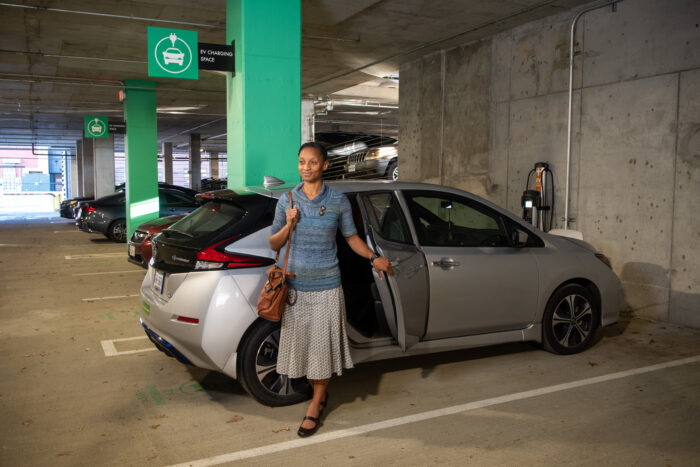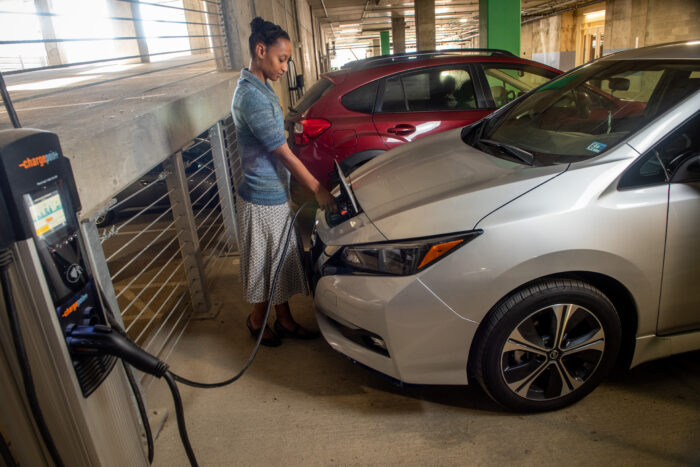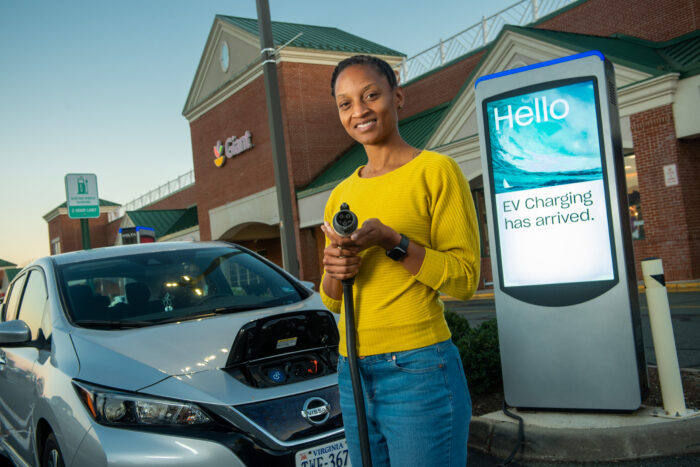SELC’s ‘Unofficial EV Ambassador’ on driving electric
Transportation is the largest source of climate-changing pollution in the country and in the South.
SELC’s Rachel James is one of many people making the personal switch to an electric vehicle in order to help reduce carbon emissions, while pushing for an overall strategy that improves public transportation and walkability, too.
Read the Q&A to learn more about how investing in an electric Nissan Leaf last summer has helped this environmental attorney “walk the walk,” and introduced her to a new world of distinct backup chimes and “the best” people out there.
Tell us about some of the benefits you’ve experienced while driving an EV.

This might sound terribly cliche, but it feels nice to drive and know I’m not emitting carbon dioxide. That’s really why I wanted the EV. I couldn’t feel good about being an environmental attorney and making my commute and running errands every day in an internal combustion engine vehicle.
Also, I had an older car before, so my daughter definitely appreciates that this one is nicer. It’s so quiet and the ride is so smooth. There are comfort and technology improvements in this vehicle that we’re able to enjoy together.
Before coming to SELC, you worked on transportation electrification with the Hawaii Public Utilities Commission. How did that experience influence your decision to go electric?
In Hawaii, I had an internal combustion engine vehicle and so did pretty much the whole team that worked on transportation electrification. That didn’t stop our commitment to supporting clean transportation solutions, instead it spurred our drive to connect with experienced drivers and experts in the field. Coming to SELC, however, afforded me the opportunity to align my work and personal life to better reflect the ecosystem we’re trying to create.
Tell Virginia leaders clean cars are the future.
Who are EVs for?
An exciting part about working in this field and having an EV is thinking about who they’re actually for. It’s making us look more closely at how people live and what they have access to. In addition to increasing the number of chargers along highways, we also talk about what charging infrastructure looks like in neighborhoods that are primarily apartment complexes. We have to be thinking about what’s needed to make sure people can not only buy the car, but actually own it and enjoy it, too.
I think it’s more of a conversation about who has access to supports that enable EV ownership. Expanding access to EVs involves considering who can afford the sticker price and ensuring EV owners have charging opportunities at home or in their immediate locale. If a person does not have at home charging options available, they will need to integrate finding a public charger into their commute and will have to hope it’s available when needed. Not everyone has the luxury of a flexible start or end time if an extra 30 minutes gets added to their day because they aren’t able to use the charger they originally intended to use.
Is there any truth to charger challenge?

I haven’t actually experienced going somewhere and unexpectedly not being able to find a place to charge, but I have had to wait my turn and I can see how locating available chargers can be challenging. You just learn to plan differently when you’re taking a carbon-emission-free road trip.
When I drove from where I live in Chester to Roanoke to take the Bar Exam last July, I was eventually able to find an operable charger, but the first one I mapped out and stopped at wasn’t actually available. You have to make sure there’s a charger where you’re going, make sure it’s operable, and make sure it’s available. Technology, both in an EV and externally in a phone application, offers much of this information.
Are there any misconceptions about EVs you can speak to?
I hear it less, but for a time people thought EVs wouldn’t have much power or pickup speed. When people drive my car, they’re sometimes surprised by how it drives like a “regular” car and say it’s not as different as they anticipated.
I know there’s a serious concern that EVs could cause accidents because they’re so quiet. There is truth that the cars are quiet, but especially newer EVs have sounds and other notices that alert pedestrians and drivers when you’re nearby — including a backup chime that my daughter and I are learning to find great pleasure in. Our car’s sound is very unique, so we always know there’s another Leaf nearby when we hear the chime.
This is going to sound totally biased, but EV owners are the best people.
Rachel James
Do you have any advice for folks who are interested in purchasing their first EV?
If you know any EV owners, drive their car or attend an EV ride and drive event.

Be aware that there can be various state and/or county fees associated with EV ownership that dealerships aren’t always informed about. Car dealerships are learning the details of EV ownership and what it entails, so don’t hesitate to ask questions as it might help increase their knowledge as well. Other things to research about the vehicle you’re considering should include its charging port and capabilities. If you are going to charge at home, look up whether your electric utility provider has any EV-related programs and their specific rates for charging. See what federal and state tax incentives may apply to you. And check out EV charging apps or your state’s Department of Transportation to see what infrastructure is available near you. There’s a bit of research that falls outside of the traditional car buying experience, but gaining the insight is priceless.
Anything else you want to share?
I love that I get to meet people when I’m charging my car. This is going to sound totally biased, but EV owners are the best people. Because of the work I do, charging is really fun because it’s kind of investigatory. The technology is just new enough that people are interested and asking each other about their cars and experiences. We really like to ask about range, too! In weekly meetings at SELC, we joke that I have taken on the role of Unofficial EV Ambassador, and I like to give people updates on who I met and what I learned while charging.
